Nvidia: AI Leadership Key To Continuous Double-Digit Stock Price Growth
Sep. 06, 2021 7:50 PM ET NVIDIA Corporation (NVDA) 15 Comments10 Likes
Khaveen Investments
Summary
- The company’s share price has surged 42% along with its revenues at 54%, we aimed to determine if the share price has reached its peak or if there is more.
- It is advancing its AI leadership to capture growth opportunities in the booming cloud market fueled by the rising volume of data.
- We determine that pricing increase rather than shipment growth was the key to its PC GPU sales, and its pricing power was due to its performance improvements with every new.
- Despite the company’s Arm acquisition still pending regulatory approval, it has gone ahead in advancing its product development with Arm’s architecture, with its new BlueField DPU and Nvidia Grace.
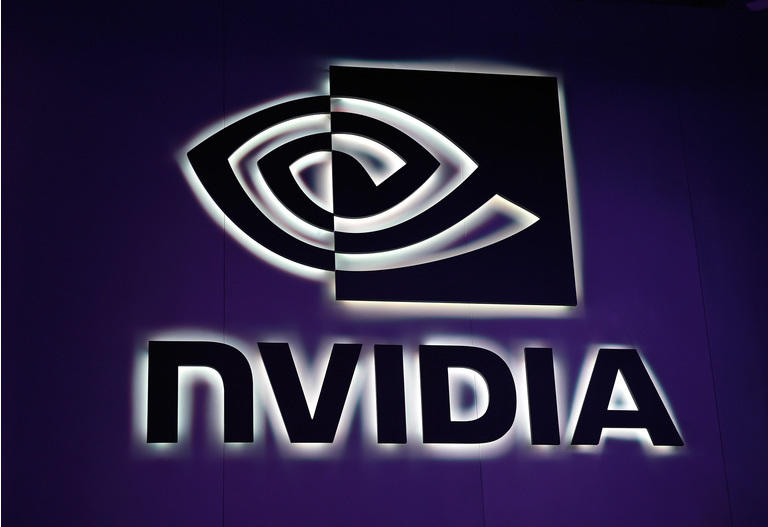
David Becker/Getty Images News
Since our previous analysis on Nvidia Corp ( NVDA), the company’s full-year revenues have increased by 53% in 2020 which has exceeded our expectations of 43% growth with higher GPU sales across PC and data center markets. As such, the company’s stock price also surges well past our previous price target of $578.39. In this analysis, we determine if its impressive growth can continue and justify a higher valuation for the company.
The main segments of the company contributing to its high growth were the Data center & Gaming segment representing 40.2% and 46.5% of its total revenues respectively. We identified Nvidia’s AI leadership as a key advantage fuelling the growth across its data center segment capitalizing on rising data creation from AI, HPC and IoT applications with its AI leadership through its innovative products catered towards the booming cloud market. Besides data centers, gaming continues to be a key driver with its continuous performance improvements backed by new releases of next-generation GPU models contributing to rising pricing power to maintain ASP growth.
Finally, we followed up on the Arm acquisition which is slated by management to conclude by early 2022. Through the acquisition of Arm, it not only earns incremental licensing revenue but also the ability to further leverage its CPU capabilities to develop and expand its range of Arm-based products including upcoming CPUs launches and the latest DPU SoCs. As the company is in the progress of obtaining regulatory clearance, we analysed the effect of the acquisition on the market competitiveness of the CPU markets.

Source: Nvidia
AI Leadership ensures High Growth Across Key Data Centre Segment
The increasing volumes of data created will fuel data center growth over the next decade. An important aspect of this will be machine-to-machine and Artificial Intelligence ('AI') technologies that enable massive volumes of data to be processed with ease and speed. AI data processing is made possible by a system of linked supercomputers that are used to process complex workloads by running millions of simulations and financial models to generate predictions from massive volumes of data by identifying a pattern and then replicating that pattern identification across other data. As can be imagined, AI computing would require massive computing infrastructure.
Driven by the advent of AI, HPC, IoT and edge computing, data creation is projected to grow at a rate of around23% in the next 5 years. This would require greater cloud infrastructure to handle the increase in data. To determine the growth in cloud infrastructure revenues, we identified the factor of correlation of cloud infrastructure revenues to data volume growth over the past 10 years. The factor identified of 1.65x was applied to data volume growth projections to estimate the cloud infrastructure market growth rate to the year 2025.

Source: Statista, Khaveen Investments
Volume of Data Worldwide
| 2016
| 2017
| 2018
| 2019
| 2020
| 2021F
| 2022F
| 2023F
| 2024F
| 2025F
| Cloud Infrastructure Market Revenues ($ bln)
| 32
| 46.5
| 69
| 96
| 129.5
| 178.9
| 246.3
| 342.9
| 470.6
| 650.6
| Cloud Infrastructure Market Revenue Growth % ('a')
| 52%
| 45%
| 48%
| 39%
| 35%
| 38%
| 38%
| 39%
| 37%
| 38%
| Data Volume (ZB)
| 18
| 26
| 33
| 41
| 64.2
| 79
| 97
| 120
| 147
| 181
| Data Volume Growth % ('b')
| 16%
| 44%
| 27%
| 24%
| 57%
| 23%
| 23%
| 24%
| 23%
| 23%
| Cloud Infrastructure Revenue Growth/Data Volume Growth Factor ('c')
| 3.25
| 1.02
| 1.80
| 1.61
| 0.62
| 1.65
| 1.65
| 1.65
| 1.65
| 1.65
|
*A =C x B
Source: Statista, Khaveen Investments
As mentioned, Artificial Intelligence ('AI') will play a crucial role in synthesizing and storing these waves of data. The race of AI computing technology is being led by semiconductor companies that create the chips that enable technology across all segments of the market. As such, innovations in AI have been especially expeditious in the semiconductor industry with several companies such as Nvidia, Intel and AMD developing significant AI capabilities in their chip systems.
We view Nvidia in particular, as not just an AI leader of the semiconductor industry, but as the AI leader of the world. Nvidia aims to develop AI solutions for every industry and is already well on the way there. It is the leader in autonomous vehicles, with its AI-enabled Advanced Driver Assistance Systems (ADAS) being developed for global automakers, having already secured $8 bln in automotive design wins. Notwithstanding, Nvidia’s automotive segment only represents3.2% of its revenues. Nvidia’s key data center segment that represents 40.2% of its revenues, is where the company’s AI leadership is really seen. The company recently announced that its AI-powered DGX server has been adopted by the top 10 Aerospace companies, 6 of the top 10 US banks, and 8 out of the 10 top global telcos.

Source: Statista
As data volume and workload grow, it gets more difficult to transmit the data. To tackle this, enterprises are expected to bring applications and storage closer to themselves rather than transporting resources to a central location. As a result, large enterprises are more likely to build on-site data storage centers which require the use of an on-site fully built server system. This is where Nvidia’s latest DGX server comes into play. To put things in perspective, these aren’t the $500 GPU chipsets used in PCs. The GPU-enabled DGX servers are provided on a subscription model, with a single one costing a massive $4.3 million a year. As to the capability of DGX, its initial design was reported to have one of the world’s fastest AI workload speeds by the National Energy Research Scientific Computer Center (NERSC). Given both the first mover and technological advantage that Nvidia has, we see the company in a prime position to capture the on-premises server market in addition to the cloud server market. As such we expect the company’s data segment revenue as a percentage of total cloud capex to continue increasing at 3%. This was derived through our calculations by first estimating the total capex by the top 4 cloud providers (Amazon ( AMZN), Microsoft ( MSFT), Google ( GOOG), Alibaba ( BABA)) and adjusted by its market share as the total cloud capex.
Cloud Providers Capex ($ mln)
| 2011
| 2012
| 2013
| 2014
| 2015
| 2016
| 2017
| 2018
| 2019
| 2020
| Amazon
| 3,785
| 3,444
| 4,893
| 5,387
| 7,804
| 11,955
| 13,427
| 16,861
| 40,140
| 45,427
| Microsoft
| 2,355
| 2,305
| 4,257
| 5,485
| 5,944
| 8,343
| 8,129
| 11,632
| 13,925
| 15,441
| Google
| 3,438
| 3,273
| 7,358
| 11,014
| 9,950
| 10,212
| 13,184
| 25,139
| 23,548
| 22,281
| Alibaba
| | | 403
| 768
| 1,243
| 1,680
| 1,598
| 3,129
| 5,287
| 4,596
| Total (Top 4)
| 9,578
| 9,022
| 16,911
| 22,654
| 24,941
| 32,190
| 36,338
| 56,761
| 82,900
| 87,745
|
Source: Nvidia, Amazon, Microsoft, Google, Alibaba, Khaveen Investments
We then estimated the total cloud capex growth rate by basing it on the forecasted growth in the cloud infrastructure revenues on a 10-year average factor of 0.68x. With the growth in cloud capex, we computed Nvidia’s share of capex spending which has been growing at 3% on average in the past 7 years. Nvidia’s AI-powered GPU accelerators are deployed in more than 97% of all AI-accelerator hardware used by the top 4 cloud providers (Amazon, Google, Microsoft, and Alibaba). These top 4 cloud providers alone control 67%. Applying our estimated share of capex, we forecasted its total data center revenues growing at around 30%.
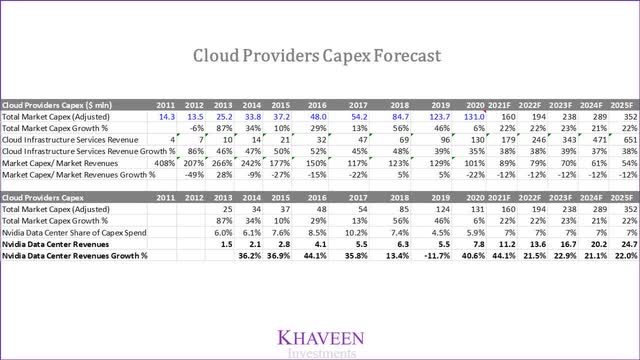
Source: Nvidia, Amazon, Microsoft, Google, Alibaba, Statista, Khaveen Investments
Continuous Performance Excellence Leads to Continuous Pricing Premium
Nvidia’s Gaming segment revenue growth has averaged a stellar 27% in the past 7 years. The main contributor is rising ASPs which averaged 27% whereas shipments growth was flat. Although Nvidia accounts for 81% of the discrete GPU market share and steadily rising, its market share in the overall GPU market has declined slightly against AMD ( AMD) and Intel ( INTC) who also manufactures integrated GPUs but is planning to develop its Alchemist product while Nvidia only produces discrete chips.
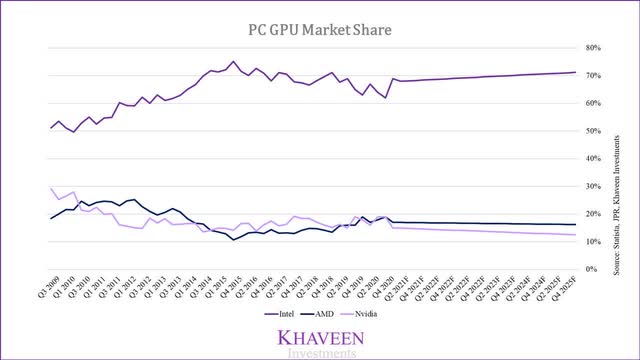
Source: Statista, JPR, Khaveen Investments
Based on its stagnant share of the overall GPU market, this implies that demand for the integrated GPU market continues to remain strong. PC shipments grew at -0.8% within the same period. Whereas GPU unit shipments were lower than the PC shipment growth with an average of -2%. One of the attributable factors is the rising GPU costs relative to stagnant PC prices. In the past 5 years, Nvidia’s average ASP as a percentage of PC ASP has risen from 19% to 38%, making it harder for PC makers to cater to the mid-range and entry-level markets which presence remains stable. As costs continue to increase and Intel seeks to capitalize on its refreshed Intel Iris Xe integrated chips, we see Nvidia’s share of overall GPUs to decline and PC shipments CAGR of 3% through 2025.
Gaming PC Share of Market Revenues
| 2016
| 2020
| High End
| 43%
| 47%
| Mid-Range
| 35%
| 34%
| Entry Level
| 22%
| 19%
|
Source: JPR
However, every year, Nvidia releases a new product lineup offering better performance against the previous models. From GPUCheck, we obtained the average benchmark score of all GPU models released for each year to obtain an average score and the average performance increase at 22% per year. Then, the average performance increase is compared to the increase in Nvidia’s ASPs for each year to derive the ASP growth to performance growth factor average of 1.1x. This implies that Nvidia’s GPU performance increase can sustain its ASP growth at a factor of 1.1x. We believe this to be fair, given the company’s solid track record of continuous product development. Its next generation of GPUs with the Ampere Next architecture is expected to be launched next year with the anticipated RTX 4000 series a successor to its current lineup. One of the major significant upgrades anticipated is the switch towards TSMC’s (NYSE: TSM) N5 process allowing even more GPU cores and transistors than the current Ampere GPUs manufactured on TSMC’s N7 and Samsung ( OTC:SSNLF) 8N process. Even longer-term, the company’s roadmaps indicate continued innovation with the following generation of ‘Ampere Next Next’ expected in 2024 which could utilize TSMC’s N3 process.
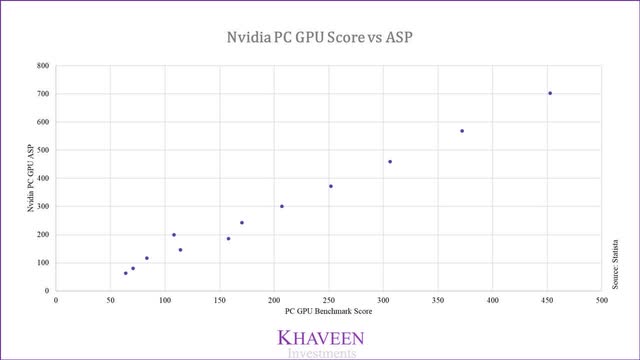
Source: Statista, GPU Checker, Khaveen Investments
Year
| Average Score
| Average Score Increase ('a')
| ASP Increase ('b')
| ASP/Score Increase Factor ('c')
| 2025F
| 452.5
| 22%
| 24%
| 1.10
| 2024F
| 372.2
| 22%
| 24%
| 1.10
| 2023F
| 306.1
| 22%
| 24%
| 1.10
| 2022F
| 251.7
| 22%
| 24%
| 1.10
| 2021F
| 207.0
| 22%
| 24%
| 1.10
| 2020
| 170.3
| 57%
| 22%
| 0.38
| 2019
| 108.2
| -32%
| 7%
| -0.23
| 2018
| 158.0
| 39%
| 27%
| 0.70
| 2017
| 114
| 37%
| 25%
| 0.69
| 2016
| 83.4
| 18%
| 45%
| 2.51
| 2015
| 70.6
| 10%
| 26%
| 2.52
| 2014
| 64
| | | | Average
| | 22%
| | 1.10
|
*B = A x C
Source: Nvidia, Statista, JPR, GPU Checker
All in all, the main driver of gaming revenues is rising prices from continuous product development rather than unit shipments. Nonetheless, the robust demand on GPU shipments seen based on data from JPR indicates a major tailwind in 2021 and forecasted a growth rate of 36% based on the average GPU shipments growth rates of Q1 and Q2. Though we expect growth to normalize, and we based our shipment growth assumption beyond 2021 on a 3.5% CAGR through 2025. Also, accounting for Nvidia’s market share in GPUs, we derived its total unit shipment as well as ASP growth to forecast its total gaming revenue growth.

Source: Nvidia, Statista, JPR
Annualized Nvidia
| 2016
| 2017
| 2018
| 2019
| 2020
| 2021F
| 2022F
| 2023F
| 2024F
| 2025F
| Shipments ('a')
| 34.76
| 37.67
| 33.58
| 27.68
| 31.95
| 43.45
| 44.97
| 46.55
| 48.18
| 49.86
| Shipments Growth %
| -1%
| 8%
| -11%
| -18%
| 15%
| 36.0%
| 3.5%
| 3.5%
| 3.5%
| 3.5%
| ASPs ('b')
| 116.8
| 146.4
| 186.1
| 199.4
| 242.8
| 300.4
| 371.5
| 459.5
| 568.3
| 702.8
| ASP Growth %
| 45%
| 25%
| 27%
| 7%
| 22%
| 24%
| 24%
| 24%
| 24%
| 24%
| Gaming Revenues ($ mln) ('c')
| 4,060
| 5,513
| 6,250
| 5,518
| 7,759
| 13,051
| 16,707
| 21,386
| 27,377
| 35,045
| Gaming Revenues Growth %
| 44.1%
| 35.8%
| 13.4%
| -11.7%
| 40.6%
| 68.2%
| 28.0%
| 28.0%
| 28.0%
| 28.0%
|
*C = A x B
Source: Nvidia, Statista, JPR, WCCF Tech
Growth From Arm Regardless of Acquisition Approval
Already a leading developer of GPUs, Nvidia is using its advantage in AI to produce a range of new products. It is acquiring Arm to leverage its CPU capabilities across key industries as seen with the expansion of its Certified Systems with BlueField DPU SoCs featuring 22 bln transistors and incorporating 16 Arm-based CPUs along with a 400 gigabits-per-second networking chip. The combination of both company’s capabilities with CPU from Arm and Mellanox networking solution for an advanced chip enhanced by is AI Enterprise software suite in partnership with VMware ( VMW) vSphere creating a new market for Nvidia. The company has already received strong support from customers including Dell Technologies ( DELL), Inspur ( OTC:INPRF), Lenovo ( OTCPK:LNVGY) and Supermicro integrating its DPUs into their systems. Besides that, cloud service providers such as Baidu are using its DPUs to accelerate workloads. Additionally, it is also planning to enter the data center CPU market with Nvidia Grace against incumbents Intel and AMD.
That said, the deal is pending regulatory approval and management is expecting to obtain clearance by early 2022. The HHI index is a measure of market competitiveness commonly used by governmental bodies such as the FTC and the Department of Justice in M&A deals. It serves as guidance whether a deal would go through, or antitrust action would be taken depending on the concentration level.
Post-Merger HHI
| Change from Premerger HHI
| Antitrust Action
| HHI < 1000
Not concentrated,
| Any
| No action likely
| 1000 < HHI < 1800
Moderately Concentrated,
| >100
| Moderately Concentrated, Possible Action
| 1800 < HHI
Highly Concentrated,
| >50
| Challenge very Likely
|
Source: OpenTextBC
For the Arm deal, the HHI calculation would be applied on the PC CPU and server market shares only as only Nvidia, AMD and Intel compete within the GPU markets. In Nvidia’s case, the HHI value for both markets would not change as it represents Arm’s share. For example, the PC CPU market HHI is valued at 4,312 in both pre-and post-acquisition.
PC CPU Market Pre-Acquisition
| Share
| s
| s^2
| PC CPU Market Post Acquisition
| Share
| s
| s^2
| Intel
| 54%
| 54
| 2916
| Intel
| 54%
| 54
| 2916
| AMD
| 36%
| 36
| 1296
| AMD
| 36%
| 36
| 1296
| Arm
| 10%
| 10
| 100
| Nvidia
| 10%
| 10
| 100
| Total
| | | 4312
| Total
| | | 4312
|
Source: Statista, PCMag
Similarly, the CPU market for servers would derive the same HHI score as the PC CPU market as Nvidia would replace Arm’s share. There is no change to the HHI score of 6,334.
Server CPU Market Share Pre-Acquisition
| Share
| s
| s^2
| Server CPU Post Acquisition
| Share
| s
| s^2
| Intel
| 78%
| 78
| 6084
| Intel
| 78%
| 78
| 6084
| AMD
| 9%
| 9
| 81
| AMD
| 9%
| 9
| 81
| Arm
| 13%
| 13
| 169
| Nvidia
| 13%
| 13
| 169
| Total
| | | 6334
| Total
| | | 6334
|
Source: Nextplatform, Itcandor
If we consider Nvidia’s planned entry to the server CPU market with the launch of Nvidia Grace. Even a small increase in share for Nvidia would lead to a reduction in the HHI value by 188. This highlights Intel’s incredibly high market share. Even if the deal does not go through, the market would still become more competitive. Thus, based on the change in HHI values, Nvidia has a rather unique case for the deal going through. It does not compete with Arm directly PC and server CPU markets, it would just take up Arm’s market share and would not lead to any change to the HHI. In fact, it could make the market even more competitive.
- Regulators are "looking to ensure that their markets are pro-competitive, that this is pro-innovation… and this is good for customers. We can prove that and show that and demonstrate that overwhelmingly, so I have no concerns. - Jen-Hsun Huang, CEO of Nvidia
Server CPU Market Share Pre-Acquisition
| Share
| s
| s^2
| Server CPU Post Acquisition
| Share
| s
| s^2
| Intel
| 78%
| 78
| 6084
| Intel
| 77%
| 77
| 5929
| AMD
| 9%
| 9
| 81
| AMD
| 8%
| 8
| 64
| Arm
| 13%
| 13
| 169
| Arm
| 12%
| 12
| 144
| -
| | | | Nvidia
| 3%
| 3
| 9
| Total
| | | 6334
| Total
| | | 6146
|
Source: Nextplatform, Itcandor, Khaveen Investments
Furthermore, Nvidia’s acquisition comes at a time when M&A activity has risen in the semiconductor market with the average deal value rising by more than 5 times since 2015. Should the deal go through, it would make it the most valuable semicon deal in history at $40 bln. Though, larger deals in the past have broken down due to antitrust. Out of 32 of the largest deals since 2015, only 3 major deals above $1 bln have fallen apart representing a 9.3% rejection rate including KLA ( KLAC) and Lam Research ( LRCX) merger, Qualcomm ( QCOM) acquisition of NXP (NASDAQ: NXPI) and Broadcom’s ( AVGO) acquisition of Qualcomm. On the other hand, smaller deals valued at below $1 bln had fewer issues with antitrust. Of the 98 deals, only 4 deals were stopped by regulators which is a 4% rejection rate. This implies that larger deals attract greater scrutiny, which is negative for Nvidia considering it is the highest valued semicon deal.
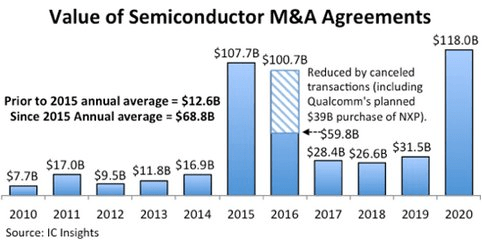
Source: Design&Reuse
Acquisition Approval Risk
Initially, the expectation of the Arm acquisition deal to go through is by Q1 2022 but subject to regulatory approval from various governmental bodies. There are several arguments that the deal might be delayed or would ultimately fail to get approval. Based on our previous analysis, we highlighted several headwinds that could arise from regulators across various jurisdictions which include:
Tensions between the US and China and to protect Arm China against possible intervention by foreign governments in the futureThe intention for the UK to protect its local industry and prioritize local jobs, technological expertise and intellectual propertyEuropean authorities seeking to protect companies’ access to advanced technology and preserve sovereignty and independenceWhile management stated its confidence that the Arm deal would go through as planned, these headwinds may pose a risk for the company to meet its deadline. In the Q2 2022 earnings briefing, Nvidia acknowledged the headwinds in obtaining regulatory approval which is taking longer than initially thought.
We are working through the regulatory process, although some Arm licensees have expressed concerns and objected to the transaction, and discussions with regulators are taking longer than initially thought - Nvidia CFO Colette Kress
A breakdown of the agreement could lead to the company incurring fees related to the failure of the acquisition. A couple of months ago, the deal faced several risks of being delayed as seen with the European regulator’s reluctance to consider the case until after the summer holidays to gather more information. Nvidia is reported to notify the European Commission in early September as the EU is set to launch a formal probe into the deal. Also, the US FTC has been seeking to gather more information while Big Techs including Google, Microsoft, and Qualcomm complained about limiting competition. Whereas in China, the company applied with Chinese authorities but appears to be facing tensions with the axed CEO of Arm China which is challenging the company for unfair dismissal.
It is believed that the agreement allows both companies to extend the deal to Q3 2022 but either party could walk away beyond that. That said, even the deal fails to go through, we believe that the company may be able to realize synergies anyway given its strong product development in the pipeline.
Valuation
The company has had an average revenue growth rate of 29.01% in the past 5 years with average gross and net margins of 61.05% and 28.4% respectively. The strength of its earnings and margins is its increasing margin as a result of lower COGS as a percentage of revenues which declined by 3.9% on average in the past 10 years. In comparison to other chipmakers, Nvidia’s gross margins are higher than the industry average of 47.2% and net margins of 13.2% which highlights its superior pricing power which saw ASPs rising by 25% on average in the past 6 years due to its dominance over the discrete GPU market.

Source: Nvidia, Khaveen Investments
In terms of cash flows, the company’s 5-year average FCF margin is 15.14% and has steadily increased as it grows its operating cash flows. Its margins appear to be volatile due to its investments in marketable securities with an inflow of $6.6 bln in 2019 and an outflow of $10 bln in 2020. However, excluding this, it has very high levels of cash generation with an adjusted average FCF margin of 29.1%. Thus, it is not only saving up for larger acquisitions in the future, but it indicates its solid profitability and earning power which would make it highly valuable even when growth slows down.
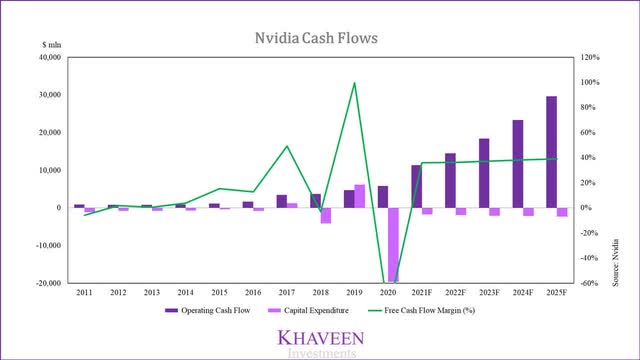
Source: Nvidia, Khaveen Investments
Moreover, the company has a strong balance sheet with a debt-to-equity ratio of 0.7x in 2020 with a high EBITDA interest coverage of 114x in the past 5 years indicating its solid ability to repay its debts. In comparison with other chipmaker competitors, its debt-to-equity is significantly lower than the average of 1.35x which highlights its advantage as a fabless chipmaker with a lean balance sheet.
We valued the company based on a P/S valuation due to its superb revenue growth as a rapidly growing company. To determine the appropriate P/S multiple to use, we calculated the average P/S ratio of the chipmakers according to their 5-year CAGR.
Average Chipmaker Revenue CAGR (5Yrs)
| PS Ratio
| 35%+
| 25.07
| 30%-35%
| 22.03
| 25%-30%
| 20.00
| 20%-25%
| 15.95
| 15% -20%
| 11.73
| 10%-15%
| 7.52
| 0%-10%
| 6.76
|
Source: SeekingAlpha, Khaveen Investments
Firstly, we forecasted its revenues through 2025 without including Arm based on Nvidia growth in gaming and data center as discussed above. The automotive revenues are projected based on a 22% CAGR derived from its $8 bln automotive pipeline assuming it realizes it by 2025. The professional visualization segment is based on the workstation market CAGR of 9.8% from 2022 through 2025 while the OEM revenues are based on annualized results in 2021.
Nvidia Revenue Forecast Without Arm ($ mln)
| 2020
| 2021F
| 2022F
| 2023F
| 2024F
| 2025F
| Gaming
| 7,759
| 13,051
| 16,707
| 21,386
| 27,377
| 35,045
| Professional Visualization
| 1,053
| 1,782
| 1,957
| 2,148
| 2,359
| 2,590
| Data Center
| 6,696
| 9,649
| 11,727
| 14,410
| 17,452
| 21,298
| Automotive
| 536
| 654
| 798
| 973
| 1,187
| 1,449
| OEM and Other
| 631
| 1,472
| 1,472
| 1,472
| 1,472
| 1,472
| Total
| 16,675
| 26,608
| 32,660
| 40,390
| 49,847
| 61,853
| Growth %
| 53%
| 59.6%
| 22.7%
| 23.7%
| 23.4%
| 24.1%
|
Source: Nvidia, Khaveen Investments
In addition, we previously computed the potential synergies from Arm should the deal go through as planned in 2022. Furthermore, Arm’s revenues are also included in the forecast.
Synergies ($ mln)
| 2022F
| 2023F
| 2024F
| 2025F
| Gaming
| 742
| 1,993
| 4,018
| 6,327
| Professional Visualization
| 90
| 205
| 351
| 489
| Data Center
| 459
| 1,406
| 3,230
| 5,694
| Automotive
| 25
| 69
| 140
| 207
| Total Synergies
| 1,316
| 3,673
| 7,739
| 12,717
| Arm Revenues
| 2,145
| 2,280
| 2,423
| 2,576
|
Source: Nvidia, Khaveen Investments
Bear Case
The bear case valuation assumes a 25% probability of the deal going through should the company face challenges from antitrust regulators. Also, the bear case assumes 80% of synergies and Arm revenues would be realized.
Bear Case
| 2021F
| 2022F
| 2023F
| 2024F
| 2025F
| Nvidia revenues ($ mln)
| 26,608
| 33,995
| 42,265
| 52,607
| 65,685
| Growth %
| 59.6%
| 27.8%
| 24.3%
| 24.5%
| 24.9%
| P/S Ratio
| 25.07
| 20.00
| 15.95
| 15.95
| 15.95
| Valuation ($ mln)
| 667,068
| 680,022
| 674,119
| 839,081
| 1,047,673
| Number of shares outstanding ('mln')
| 2,490
| 2,490
| 2,490
| 2,490
| 2,490
| Target Share Price
| $267.90
| $273.10
| $270.73
| $336.98
| $420.75
| Current Share Price
| $223.96
| $223.96
| $223.96
| $223.96
| $223.96
| Upside
| 19.6%
| 21.9%
| 20.9%
| 50.5%
| 87.9%
|
Source: Khaveen Investments
Base Case
Whereas the base case assumes a 50% probability on the basis of its continued progress to complete the deal but also the possible delays due to regulators requiring more information. Also, we assume 100% of synergies to be realised through the acquisition.
Base Case
| 2021F
| 2022F
| 2023F
| 2024F
| 2025F
| Nvidia revenues ($ mln)
| 26,608
| 34,927
| 43,937
| 55,534
| 70,144
| Growth %
| 59.6%
| 31.3%
| 25.8%
| 26.4%
| 26.3%
| P/S Ratio
| 25.07
| 22.03
| 20.00
| 20.00
| 20.00
| Valuation ($ mln)
| 667,068
| 769,432
| 878,877
| 1,110,874
| 1,403,114
| Number of shares outstanding ('mln')
| 2,490
| 2,490
| 2,490
| 2,490
| 2,490
| Target Share Price
| $267.90
| $309.01
| $352.96
| $446.13
| $563.50
| Current Share Price
| $223.96
| $223.96
| $223.96
| $223.96
| $223.96
| Upside
| 19.6%
| 38.0%
| 57.6%
| 99.2%
| 151.6%
|
Source: Khaveen Investments
Bull Case
Finally, the bull case assumes a 100% probability as we believe the acquisition would not lead to greater market concentration but rather a more competitive one as its case for the deal to go through. Also, we assume 120% of synergies to be realised through the acquisition.
Bull Case
| 2021F
| 2022F
| 2023F
| 2024F
| 2025F
| Nvidia revenues ($ mln)
| 26,608
| 36,384
| 47,078
| 61,558
| 79,690
| Growth %
| 59.6%
| 36.7%
| 29.4%
| 30.8%
| 29.5%
| P/S Ratio
| 25.07
| 25.07
| 20.00
| 22.03
| 20.00
| Valuation ($ mln)
| 667,068
| 912,153
| 941,714
| 1,356,113
| 1,594,068
| Number of shares outstanding ('mln')
| 2,490
| 2,490
| 2,490
| 2,490
| 2,490
| Target Share Price
| $267.90
| $366.33
| $378.20
| $544.62
| $640.19
| Current Share Price
| $223.96
| $223.96
| $223.96
| $223.96
| $223.96
| Upside
| 19.6%
| 63.6%
| 68.9%
| 143.2%
| 185.8%
|
Source: Khaveen Investments
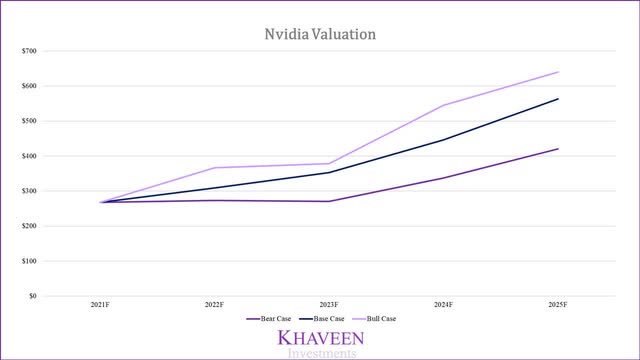
Source: Khaveen Investments
Our 1-year average price target for the bear, base and bull case is $270.50, $288.45, $317.11 with an upside of 20.8%, 28.8% and 41.6% respectively.
1-year Average Price Target
| Target Price
| Current Price
| Upside
| Bear Case
| $270.50
| $223.96
| 20.8%
| Base Case
| $288.45
| $223.96
| 28.8%
| Bull Case
| $317.11
| $223.96
| 41.6%
|
Source: Khaveen Investments
Verdict
To sum it up, the company’s growth prospects are supported by its solid innovative capabilities leading to its AI leadership and GPU performance excellence. Highlighting the advancement of its AI strategy around the data center markets, we believe it can capitalize on the booming cloud growth and increasing capex share to benefit its data center revenues. Additionally, despite the flattish shipment growth, we believe it can continue to grow its gaming revenues highlighting its consistent performance improvement with its next-gen Ampere Next based models. As it advances its AI strategy, it is looking to leverage Arm’s incredible CPU IP across its latest product R&D for the data center for future launches. Compared to our previous analysis, we applied a quantitative P/S multiple to reflect its superb growth outlook as one of the highest in the industry. Based on our valuation model using a P/S multiple, its projected revenue growth rate of 59.6% in 2021 driven by strong growth momentum across gaming and data center segments provides an upside opportunity of 28.8% as its stock price has already increased by 71% year to date. Overall, we rate the company as a Buy with a target price of $288.45.
seekingalpha.com |
















